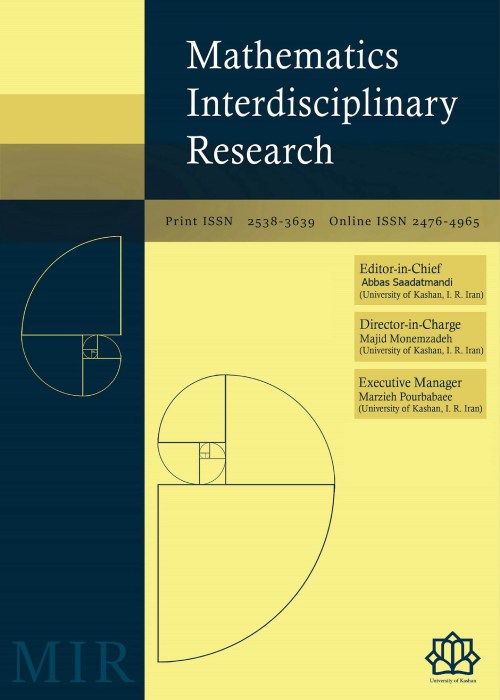فهرست مطالب
Mathematics Interdisciplinary Research
Volume:1 Issue: 2, Summer 2016
- تاریخ انتشار: 1395/04/11
- تعداد عناوین: 6
-
-
Pages 273-277
In this short article, we observe that the path of particle of mass $m$ moving along $mathbf{r}= mathbf{r}(t)$ under pseudo-force $mathbf{A}(t)$, $t$ denotes the time, is given by $mathbf{r}_d= int(frac{dmathbf{r}}{dt} mathbf{A}(t)) dt +mathbf{c}$. We also observe that the effective force $mathbf{F}_e$ on that particle due to pseudo-force $mathbf{A}(t)$, is given by $ mathbf{F}_e= mathbf{F} mathbf{A}(t)+ mathbf{L} dmathbf{A}(t)/dt$, where $mathbf{F}= m d^2mathbf{r}/dt^2 $ and $mathbf{L}= m dmathbf{r}/dt$. We have discussed stream lines under pseudo-force.the formula is not displayed correctly!
Keywords: Right loops, right transversals, gyrotransversals -
Pages 279-290
In this paper, using the contexts of C-class functions and common limitrange property, common fixed point result for some operator are obtained.Our results generalize several results in the existing literature. Some examplesare given to illustrate the usability of our approach.
Keywords: Generalized metric space_common fixed point_generalized weakly G-contraction_weakly compatible mappings_common (CLRST ) property_C-class functions -
Pages 291-304In this paper we investigate a nonlinear evolution model described by the Rosenau-KdV equation. We propose a three-level average implicit finite difference scheme for its numerical solutions and prove that this scheme is stable and convergent in the order of O(τ2 + h2). Furthermore we show the existence and uniqueness of numerical solutions. Comparing the numerical results with other methods in the literature show the efficiency and high accuracy of the proposed method. In this paper we investigate a nonlinear evolution model described by the Rosenau-KdV equation. We propose a three-level average implicit finite difference scheme for its numerical solutions and prove that this scheme is stable and convergent in the order of O(τ2 + h2). Furthermore we show the existence and uniqueness of numerical solutions. Comparing the numerical results with other methods in the literature show the efficiency and high accuracy of the proposed method. In this paper we investigate a nonlinear evolution model described by the Rosenau-KdV equation. We propose a three-level average implicit finite difference scheme for its numerical solutions and prove that this scheme is stable and convergent in the order of O(τ2 + h2). Furthermore we show the existence and uniqueness of numerical solutions. Comparing the numerical results with other methods in the literature show the efficiency and high accuracy of the proposed method.Keywords: Finite difference scheme, solvability, unconditional stability, Convergence
-
Pages 305-316Mathematical chemistry is a branch of theoretical chemistry for discussion and prediction of the molecular structure using mathematical methods without necessarily referring to quantum mechanics. In theoretical chemistry, distance-based molecular structure descriptors are used for modeling physical, pharmacologic, biological and other properties of chemical compounds. The Wiener Polarity index of a graph G is denoted by W_P (G) is the number of unordered pairs of vertices of distance 3. The Wiener polarity index is used to demonstrate quantitative structure-property relationships in a series of acyclic and cycle-containing hydrocarbons. Let G,H be two simple connected graphs. Then the tensor product of them is denoted by G⨂H whose vertex set is V(G⨂H)=V(G)×V(H) and edge set is E(G⨂H)={(a,b)(c,d)| ac∈E(G) ,bd∈E(H) }. In this paper, we aim to compute the Wiener polarity index of G⨂H which was computed wrongly in [J. Ma, Y. Shi and J. Yue, The Wiener Polarity Index of Graph Products, Ars Combin., 116 (2014) 235-244].Keywords: topological index, Wiener polarity index, tensor product, Graph, Distance
-
Pages 317-323The degree set of a graph is the set of its degrees. Kapoor et al. [Degree sets for graphs, Fund. Math. 95 (1977) 189-194] proved that for every set of positive integers, there exists a graph of diameter at most two and radius one with that degree set. Furthermore, the minimum order of such a graph is determined. A graph is 2-self- centered if its radius and diameter are two. In this paper for a given set of natural numbers greater than one, we determine the minimum order of a 2-self-centered graph with that degree set.Keywords: Degree set, self-centered graph, radius, diameter
-
Eigenfunction Expansions for Second-Order Boundary Value Problems with Separated Boundary ConditionsPages 325-334In this paper, we investigate some properties of eigenvalues and eigenfunctions of boundary value problems with separated boundary conditions. Also, we obtain formal series solutions for some partial differential equations associated with the second order differential equation, and study necessary and sufficient conditions for the negative and positive eigenvalues of the boundary value problem. Finally, by the sequence of orthogonal eigenfunctions, we provide the eigenfunction expansions for twice continuously differentiable functions.Keywords: Boundary value problem, Eigenvalue, eigenfunction, completeness, eigenfunction expansion


